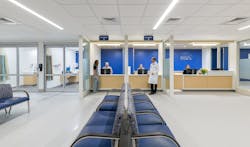Why Acoustics Matter So Much in Medical Facilities
Healthcare facilities are some of the most difficult structures in which to achieve good acoustics. From the abundance of hard surfaces to special design requirements, healthcare facilities promise a challenge—and it’s one that’s crucial to get right.
“Acoustics are really imperative to the overall design solution,” said Megan McNally, associate director of interior design for Ryan Companies, a multidisciplinary provider of commercial real estate services. “Health care is really unique in that you’re designing an environment where patients are at their most vulnerable and where it’s really critical for staff to be able to communicate and collaborate with each other. Acoustics can affect healing and medical errors as well.”
[Related: How Hospitality Spaces Become Healthcare Facilities]
Top Acoustical Challenges in Healthcare Facilities
Acoustical needs in health care vary widely depending on the type of space. The Facility Guidelines Institute lays out acoustical requirements for every space type on a granular level, but some of the keys to good acoustics in health care include:
- Sound isolation in single-patient spaces. Healthcare facility designers must be careful to make sure protected health information doesn’t travel from one space to another, especially in spaces like patient rooms and exam rooms.
- Limiting how far speech travels in common areas. For spaces like waiting rooms, where many patients congregate, isolating conversations is difficult. “Typically the things we can do in waiting rooms are to make sure there’s enough sound absorption in the ceiling, and sometimes using a sound masking system to cover up speech sounds that might travel across the waiting room,” explained Ben Davenny, principal consultant for acoustical consulting firm Acentech.
- Separating noisy equipment from sensitive areas. MRI machines, for example, are notoriously loud and must be kept away from areas where quiet is crucial.
- Designing for collaboration. It’s important for medical professionals to be able to talk to each other. Limiting reverberation via sound absorption in all spaces can help with that, and it also cuts down on sound transmission between spaces.
[Related: Security vs. Access in Healthcare Facilities]
Go-To Acoustical Strategies for Health Care
Solving acoustical problems in existing healthcare facilities can be difficult because healthcare applications require cleanable and/or sterile materials, explained Michael Wesolowsky, principal of Thornton Tomasetti, a global scientific and engineering consulting firm. However, fixing your healthcare building’s acoustical issues isn’t impossible.
“Restrictions on materials in healthcare facilities can be challenging for achieving the right acoustical environment, but there are certainly many options available,” Davenny said.
Tackle your healthcare problems by determining what’s driving the complaints. Is the mechanical system creating a noisy environment? You may need to talk to an engineer if it’s interfering with conversations or bothering people. If it’s more of an issue of not having the right finishes in a room that otherwise complies with the FGI requirements, a healthcare designer may be able to pinpoint places where you can replace furnishings, flooring or ceiling tiles to create spaces that are less reverberant. This could include:
- Ceilings: Using high-performance ceiling tiles with high Noise Reduction Coefficient ratings can make a big difference, McNally said. Perforated wood can be a beautiful option for healthcare ceilings.
- Walls: Acoustically wrapped wall panels that are cleanable are a great option for public spaces or staff support space, McNally said.
- Flooring: High-traffic spaces may need a terrazzo or porcelain option that’s highly durable, but try to offset it with carpet, rubber or linoleum wherever possible. These options “not only have sound absorptive qualities but are also softer for staff underfoot and rolling of beds,” McNally said.
- Doors: Adding gaskets or seals to doors reduces noise transmission through the door, which could be useful if the doors are allowing too much sound and information to be transmitted outside the room, Davenny said.
- Furnishings: When you specify healthcare furnishings, think about all aspects of how you’ll use the furnishings—not just focusing on the textiles they’re covered with, but their placement. “For a large-scale waiting room, look at seating that might be smaller in scale and smaller seat groupings as opposed to that airport back-to-back seating. Allow smaller groups to congregate with each other,” McNally said. “Think about opportunities for choice and variety in healthcare settings.”
Bring in An Expert
Engaging an acoustic consultant as early as possible is a crucial piece in the acoustical puzzle, Wesolowsky said.
“We usually do a lot of our work very early in the design process and set the design parameters for the architects and interior designers,” he added. “Coming in near the end of the design process and having us look at the drawings that are 95% set in stone and then go ‘What the hell were you thinking?’ costs 10 times more than having us come in early and give you that advice from the get-go.”
If you’re renovating, it can also pay to have an acoustic consultant conduct site inspections throughout the construction process, Wesolowsky added.
“We’ve seen so many mistakes in the field put in by an apprentice somewhere who didn’t know what he was doing with an isolation device, and it gets covered up by drywall,” Wesolowsky said. “Then you’ve got to rip it all down, find the problem and put it all back up again. You can avert many of these issues down the road.”
Read next: 6 Ways to Make Healthcare Facilities More Comfortable Through Design





